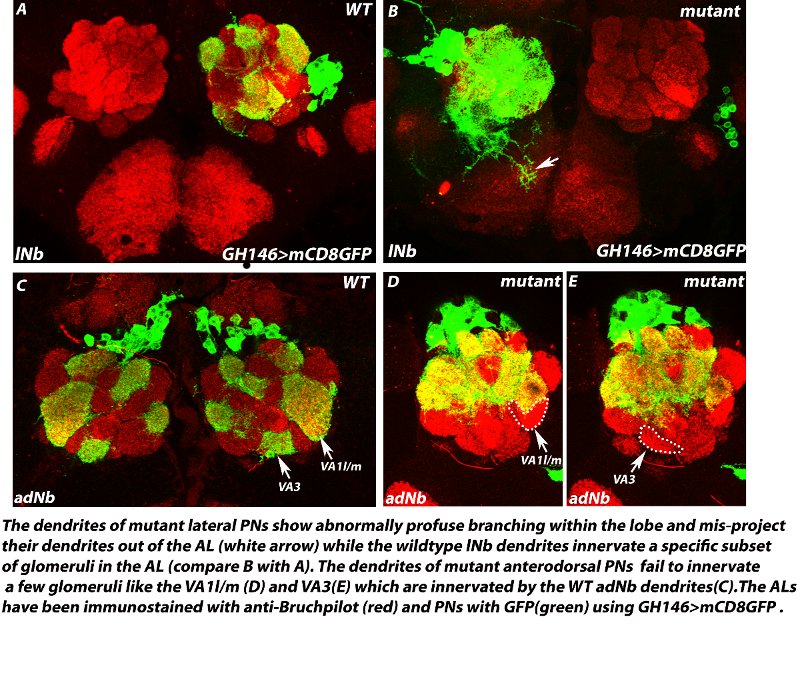Dr. Veronica Rodrigues - Development of Antenna and its Neurons
| People | Development of Antenna and its Neurons |
|
Sonia Sen
Ramveer Choudhary |
Conserved peripheral and central roles of transcription factors, empty spiracles and orthodenticle, in Drosophila olfactory system development The Drosophila brain develops from neural stem cell like precursros called neuroblasts, which form in a highly stereotyped manner in during embryogenesis. The stereotypy in the formation and specification of embryonic neuroblasts is in part controlled by key developmental patterning genes that initially define the body axes during early embryogenesis. Many of these genes continue to be expressed in neuroblasts later in embryonic and postembryonic brain development, and have functional roles there. We investigate some of these later, complex roles of early patterning genes. We have focussed on two cephalic gap genes orthodenticle (otd) and empty spiracles (ems) and are studying their role in postembryonic development of the Drosophila central nervous system and peripheral nervous system, specifically in the olfactory system. We find that these genes continue to be required reiteratively in the peripheral and central neurons of the olfactory system. Or work suggests that proper development of the circuit depends not only on genes that are expressed in olfactory lineages, which promote appropriate circuitry, but also on genes expressed elsewhere, which prevent inappropriate circuitry.
In this schematic, a neuroblast lineage that normally does not innervate the antennal lobe (left) expresses the transcription factor Otd (orange). Loss of otd function from this lineage results in the transformation of its neurons to antennal lobe projection neurons (right).
Collaborators: Heinrich Reichert, University of Basel, Switzerland. Rahul Siddharthan, The Institute of Mathematical Sciences, Chennai, India. |
|
Indu Nair |
A zinc-finger transcription factor regulates the guidance of axons and dendrites of the olfactory neurons in Drosophila melanogaster Precise guidance of growing axons and dendrites to their proper targets is indispensable for the proper development of any neural circuit which is a prerequisite for normal behaviour in animals. In the fruitfly, the olfactory receptor neurons (ORNs), typically express a single OR gene and all the ORNs expressing the same OR gene extend their axons precisely to one specific glomerulus out of about 50 glomeruli within the antennal lobe (AL), the first olfactory relay in the brain. The second order interneurons viz., the projection neurons and local interneurons also send their dendrites to specific target glomeruli to receive inputs from their respective ORN partners. Several axon guidance and cell surface molecules like have been shown to be required in this guidance process. However, there is very little understanding of the upstream transcription factors that control axon/dendrite guidance. We are investigating the role of a zinc-finger transcription factor in the guidance of axons of ORNs and dendrites of PNs and LNs during development of the Drosophila olfactory circuit. Loss-of-function of this factor causes specific mistargeting of a subset of ORN axons to one dorsolateral glomerulus in the antennal lobes. The dendrite projections of the PNs belonging to the anterodorsal lineage also show loss of innervation to specific glomeruli and the dendrites of lateral PNs and LNs misproject out of the ALs. Our study has identified a new player- a zinc finger transcription factor that seems to be part of the transcription factor code that determines the targeting of individual neurons in the olfactory system.
Collaborators: Heinrich Reichert, University of Basel, Switzerland. |






